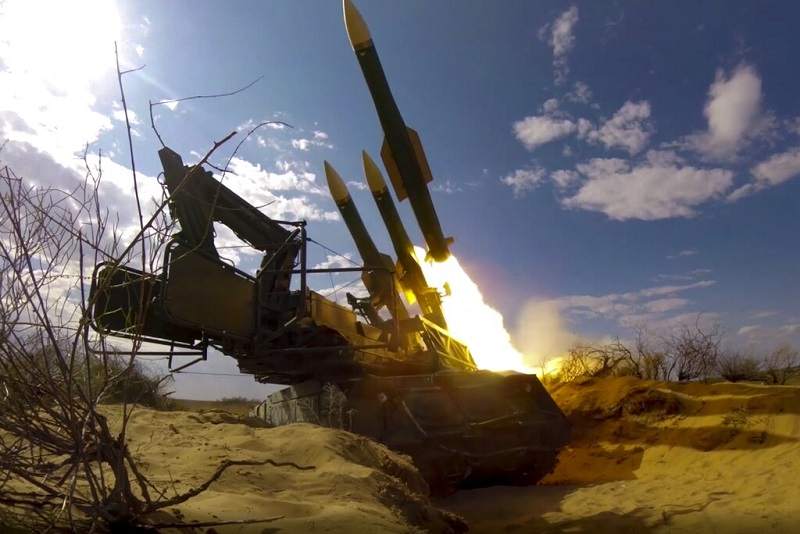
In this photo taken from a footage released on Sept. 22, 2020 by the Russian Defense Ministry Press Service, a rocket launches from a missile system at the Ashuluk military base in Southern Russia.
16:45 JST, October 14, 2022
WASHINGTON (AP) — As Russia bombarded Ukraine this week, military observers were left wondering about how many and what types of missiles Russia still has in its arsenal. In other words, how long can the Kremlin keep up the barrage?
Some analysts believe Russia could be running down its stockpiles of long-range precision weapons as the nearly 8-month-old war drags on and sanctions hit its economy, forcing it to resort to less-accurate missiles.
It remains unclear if Russia has enough weapons to continue the strikes against Ukraine with the same intensity that began following the Oct. 8 explosion on the Kerch Bridge to the Moscow-annexed Crimean Peninsula.
A look at what is known — and not known — about Russia’s arsenal:
WHAT DOES RUSSIA SAY?
Russian officials say the military has sufficient stockpiles of long-range missiles and that factories are churning out more, rejecting Western claims its supplies are shrinking.
The Russian military hasn’t said how many missiles it has fired and how many are left, and there is no data to independently assess the state of the Russian arsenal.
President Vladimir Putin recently chaired a meeting to discuss plans for boosting weapons production, but he steered clear of specifics in the introductory remarks that were televised.
WHAT HAS RUSSIA RELIED ON RECENTLY?
When the Russian military unleashed missile attacks across Ukraine starting Monday, it used the entire range of its long-range precision weapons: the Kh-55 and Kh-101 cruise missiles fired by strategic bombers, the sea-launched Kalibr cruise missiles and the ground-launched Iskander missiles.
Russian forces have also repeatedly used the S-300 surface-to-air defense missile systems for striking ground targets, which was seen by some observers as a sign of a Russian weapons shortages.
Russia’s repurposing of air defense systems and anti-ship missiles suggests it is running low on more advanced missiles that are intended to hit ground targets, said Ian Williams, a fellow at the Washington-based Center for Strategic and International Studies.
Strikes from a Russian S-300 air defense system “don’t have the ‘oomph’ to really hit hardened military targets and they don’t have the accuracy in a land attack role to even strike the building you want to hit,” Williams said. “This really is just firing them into the ether and seeing where they land.”
Their use, however, could be explained by an abundant stock of older subtypes of such missiles, which were superseded by more advanced air defense weapons, as well as the military’s desire to keep more expensive, advanced long-range missiles for priority targets.
While numbers are hard to obtain, how Russia is using its weapons is telling. In a recent strike in Mykolaiv, a surface-to-air missile was used to hit a target on the ground.
Douglas Barrie, senior fellow for military aerospace at the London-based International Institute for Strategic Studies, called that “a sure sign that missile stocks are running low.”
WHAT IS WASHINGTON SAYING?
While the Biden administration believes there is evidence that Russia has depleted stocks of its most efficient weapons, U.S. officials say there is no sign Moscow is ready or willing to relent in its recent barrages against civilian areas in Kyiv and other Ukrainian cities.
It was not immediately clear what the U.S. thinks Russia might have left. But two officials said U.S. government analysts had noted with interest that Russia had used cruise missiles, and not less expensive, shorter-range artillery or rockets, in the aftermath of the Kerch Bridge blast.
That choice, the officials said, could indicate that Russia is running low on cheaper, reliable mid-range weapons and is having trouble replenishing its stockpiles due to sanctions and supply chain disruptions.
The relative calm that Kyiv enjoyed prior to the Kerch Bridge incident may have been a sign that Russia was trying to conserve its limited resources, according to the officials, who spoke on condition of anonymity to discuss internal assessments of Russia’s military strength.
WHAT’S BEHIND THE CHOICE OF TARGETS?
Firing large numbers of inaccurate missiles could be intended to clutter air defenses while Russia uses its best missiles for high-value targets and key infrastructure.
But Williams suggested that Moscow could also be acting strategically, knowing its barrage will hit civilian targets in hopes of driving up panic in Ukraine and pushing Kyiv to accept a cease-fire favorable to Russia.
“It’s becoming more and more clear that, as they say, the cruelty is the point,” he said.
"News Services" POPULAR ARTICLE
-

American Playwright Jeremy O. Harris Arrested in Japan on Alleged Drug Smuggling
-

Japan’s Nikkei Stock Average as JGB Yields, Yen Rise on Rate-Hike Bets
-

Japan’s Nikkei Stock Average Licks Wounds after Selloff Sparked by BOJ Hike Bets (UPDATE 1)
-

Japan’s Nikkei Stock Average Buoyed by Stable Yen; SoftBank’s Slide Caps Gains (UPDATE 1)
-

Japanese Bond Yields Zoom, Stocks Slide as Rate Hike Looms
JN ACCESS RANKING
-

Keidanren Chairman Yoshinobu Tsutsui Visits Kashiwazaki-Kariwa Nuclear Power Plant; Inspects New Emergency Safety System
-

Imports of Rare Earths from China Facing Delays, May Be Caused by Deterioration of Japan-China Relations
-

University of Tokyo Professor Discusses Japanese Economic Security in Interview Ahead of Forum
-

Japan Pulls out of Vietnam Nuclear Project, Complicating Hanoi’s Power Plans
-

Govt Aims to Expand NISA Program Lineup, Abolish Age Restriction























